April 27, 2011

While planting dates are important, Purdue Extension corn specialist Bob Nielsen says plenty of other factors can influence crop yield. The prime time for planting corn to maximize yields in much of Indiana is April 20 through May 10. The window opens about a week later in northern Indiana and a week earlier in southern Indiana.
Because of the wet spring weather, very little corn has been planted. According to the USDA National Agricultural Statistics Service's (NASS) Indiana Crop and Weather Report for April 24, only 2% of Indiana's corn crop had been planted, as compared with the 15% five-year average.
"By itself, this is not much cause for concern because typically only a very small percentage of acres are ever planted by this date in Indiana," he says. "However, the specter of delayed planting is clearly on the horizon because little other fieldwork has been completed. For some growers, tillage operations, herbicide applications and nitrogen fertilizer applications must be completed first before they can consider planting their crops."
According to the USDA NASS progress reports for the past 20 years, there is not a strong relationship between planting date and absolute yield on a statewide basis for Indiana.
"It is true that corn grain yield potential does decline with delayed planting after about May 1," Nielsen says. "But the planting date only accounts for 11-12% of the variability in statewide yields from year to year."
Yield potential declines with delayed planting because of factors such as shorter growing season, insect and disease pressure and moisture stress during pollination. The good news, Nielsen says, is that planting date is just one of many yield-influencing factors (YIFs) for corn.
"What is important to understand is that yield loss to delayed planting is relative to the maximum yield potential in a given year," he says. "In other words, if all of the other YIFs work together to determine that the maximum possible yield this year is 200 bu./acre, then the consequence of a 10-day planting delay beyond May 1 would be a yield potential of 190 bu./acre.
But if all the other YIFs work together to determine that the maximum possible yield this year is only 160 bu., then the consequence of a 10-day planting delay beyond May 1 would be a yield potential of 150 bu.
Because of these other yield-influencing factors, it is possible for early planted corn in one year to yield more than, less than or equal to later-planted corn in another year – depending on the exact combinations of factors for each year, Nielsen says.
The bottom line, he says, is not to succumb to the fear triggered by the prospects of delayed planting in 2011.
"'Mudding in' a crop early to avoid planting late will almost always end up being an unwise decision," he says. "Another reason that it is probably too early to fear-monger about the anticipated late start to planting is that growers have the machinery capacity to catch up quickly once the weather and soil conditions become favorable for planting."
For more on planting date and yield-reducing factors in corn, read Nielsen's "Corn Planting Date is Important, But ..." article.
You May Also Like




